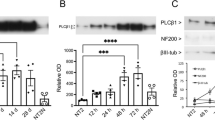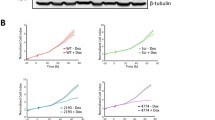Abstract
The ubiquitin-binding Rpn10 protein serves as an ubiquitin receptor that delivers client proteins to the 26S proteasome, the protein degradation complex. It has been suggested that the ubiquitin-dependent protein degradation is critical for neuronal differentiation and for preventing neurodegenerative diseases. Our previous study indicated the importance of Rpn10 in control of cellular differentiation (Shimada et al., Mol Biol Cell 17:5356–5371, 2006), though the functional relevance of Rpn10 in neuronal cell differentiation remains a mystery to be uncovered. In the present study, we have examined the level of Rpn10 in a proteasome-containing high molecular weight (HMW) protein fraction prepared from the mouse neuroblastoma cell line Neuro2a. We here report that the protein level of Rpn10 in HMW fraction from un-differentiated Neuro2a cells was significantly lower than that of other cultured cell lines. We have found that retinoic acid-induced neural differentiation of Neuro2a cells significantly stimulates the incorporation of Rpn10 into HMW fractions, although the amounts of 26S proteasome subunits were not changed. Our findings provide the first evidence that the modulation of Rpn10 is linked to the control of retinoic acid-induced differentiation of neuroblastoma cells.



Similar content being viewed by others
Abbreviations
- HMW:
-
High molecular weight protein fraction
- VWA:
-
von Willebrand A
- HEPES:
-
4,2-Hydroxyethyl-1-piperazineethanesulfonic acid
- PBS:
-
Phosphate buffered saline
- UBL:
-
Ubiquitin-like
- UIM:
-
Ubiquitin interacting motif
- RA:
-
all-trans Retinoic acid
References
Hershko A, Ciechanover A (1998) The ubiquitin system. Annu Rev Biochem 67:425–479
Herschko A, Chichanover A, Varshavsky A (2001) The ubiquitin system. Nat Med 6:1073–1081
Pickart CM (2001) Mechanisms underlying ubiquitination. Annu Rev Biochem 70:503–533
Finley D, Ciechanover A, Varshavsky A (2004) Ubiquitin as a central cellular regulator. Cell 116:S29–S32
DeMartino GN, Slaughter CA (1999) The proteasome, a novel protease regulated by multiple mechanisms. J Biol Chem 274:22123–22126
Voges D, Zwickl P, Baumeister W (1999) The 26S proteasome: a molecular machine designed for controlled proteolysis. Annu Rev Biochem 68:1015–1068
Pickart CM, Cohen RE (2004) Proteasomes and their kin: proteases in the machine age. Nat Rev Mol Cell Biol 5:177–187
Almeida A, Bolanos JP, Moreno S (2005) Cdh1/Hct1-APC is essential for the survival of postmitotic neurons. J Neurosci 25:8115–8121
Bossy-Wetzel E, Schwarzenbacher R, Lipton SA (2004) Molecular pathways to neurodegeneration. Nat Med 10 Suppl:S2–S9
Jackson PK (2006) Developmental neurobiology: a destructive switch for neurons. Nature 442:365–366
Petrucelli L, Dawson TM (2004) Mechanism of neurodegenerative disease: role of the ubiquitin proteasome system. Ann Med 36:315–320
Sakurai M, Ayukawa K, Setsuie R, Nishikawa K, Hara Y, Ohashi H, Nishimono M, Abe T, Kudo Y, Sekiguchi M, Sato Y, Aoki S, Noda M, Wada K (2006) Ubiquitin C-terminal hydrolase L1 regulates the morphology of neural progenitor cells and modulates their differentiation. J Cell Sci 119:162–171
Staropoli JF, McDermott C, Martinat C, Schulman B, Demireva E, Abeliovich A (2003) Parkin is a component of an SCF-like ubiquitin ligase complex and protects postmitotic neurons from kainate excitotoxicity. Neuron 37:735–749
Klimaschewski L, Hausott B, Ingorokva S, Pfaller K (2006) Constitutively expressed catalytic proteasomal subunits are up-regulated during neuronal differentiation and required for axon initiation, elongation and maintenance. J Neurochem 96:1708–1717
Sakata E, Yamaguchi Y, Kurimoto E, Kikuchi J, Yokoyama S, Yamada S, Kawahara H, Yokosawa H, Hattori N, Mizuno Y, Tanaka K, Kato K (2003) Parkin binds the Rpn10 subunit of 26S proteasomes through its ubiquitin-like domain. EMBO Rep 4:301–306
Shimura H, Hattori N, Kubo S, Mizuno Y, Asakawa S, Minoshima S, Shimizu N, Iwai K, Chiba T, Tanaka K, Suzuki T (2000) Familial Parkinson disease gene product, parkin, is a ubiquitin-protein ligase. Nat Genet 25:302–305
Choi J, Levey AI, Weintraub ST, Rees HD, Gearing M, Chin LS, Li L (2004) Oxidative modifications and down-regulation of ubiquitin carboxyl-terminal hydrolase L1 associated with idiopathic Parkinson’s and Alzheimer’s diseases. J Biol Chem 279:13256–13264
Gong B, Cao Z, Zheng P, Vitolo OV, Lie S, Staniszewski A, Moolman D, Zhang H, Shelanski M, Arancio O (2006) Ubiquitin hydrolase Uch-L1 rescues beta-amyloid-induced decreases in synaptic function and contextual memory. Cell 126:775–788
Deveraux Q, Ustrell V, Pickart C, Rechsteiner M (1994) A 26S protease subunit that binds ubiquitin conjugates. J Biol Chem 269:7059–7061
Ferrell K, Deveraux Q, van Nocker S, Rechsteiner M (1996) Molecular cloning and expression of a multiubiquitin chain binding subunit of the human 26S protease. FEBS Lett 381:143–148
Kawahara H, Kasahara M, Nishiyama A, Ohsumi K, Goto T, Kishimoto T, Saeki Y, Yokosawa H, Shimbara N, Murata S, Chiba T, Suzuki K, Tanaka K (2000) Developmentally regulated, alternative splicing of the Rpn10 gene generates multiple forms of 26S proteasomes. EMBO J 19:4144–4153
van Nocker S, Sadis S, Rubin DM, Glickman M, Fu H, Coux O, Wefes I, Finley D, Vierstra RD (1996) The multiubiquitin-chain-binding protein Mcb1 is a component of the 26S proteasome in Saccharomyces cerevisiae and plays a nonessential, substrate-specific role in protein turnover. Mol Cell Biol 16:6020–6028
Glickman MH, Rubin DM, Coux O, Wefes I, Pfeifer G, Cjeka Z, Baumeister W, Fried VA, Finley D (1998) A subcomplex of the proteasome regulatory particle required for ubiquitin-conjugate degradation and related to the COP9-signalosome and eIF3. Cell 94:615–623
Verma R, Oania R, Graumann J, Deshaies RJ (2004) Multiubiquitin chain receptors define a layer of substrate selectivity in the ubiquitin-proteasome system. Cell 118:99–110
Haracska L, Udvardy A (1997) Mapping the ubiquitin-binding domains in the p54 regulatory complex subunit of the Drosophila 26S protease. FEBS Lett 412:331–336
Hofmann K, Falquet LA (2001) Ubiquitin-interacting motif conserved in components of the proteasomal and lysosomal protein degradation systems. Trends Biochem Sci 26:347–350
Young P, Deveraux Q, Beal RE, Pickart CM, Rechsteiner M (1998) Characterization of two polyubiquitin-binding sites in the 26S protease subunit 5a. J Biol Chem 273:5461–5467
Hiyama H, Yokoi M, Masutani C, Sugasawa K, Maekawa T, Tanaka K, Hoeijmakers JH, Hanaoka F (1999) Interaction of hHR23 with S5a: the ubiquitin-like domain of hHR23 mediates interaction with S5a subunit of the 26S proteasome. J Biol Chem 274:28019–28025
Kikukawa Y, Minami R, Shimada M, Kobayashi M, Tanaka K, Yokosawa H, Kawahara H (2005) Unique proteasome subunit Xrpn10c is a specific receptor for the antiapoptotic ubiquitin-like protein Scythe. FEBS J 272:6373–6386
Walters KJ, Kleijnen MF, Goh AM, Wagner G, Howley PM (2002) Structural studies of the interaction between ubiquitin family proteins and proteasome subunit S5a. Biochemistry 41:1767–1777
Elsasser S, Chandler-Militello D, Muller B, Hanna J, Finley D (2004) Rad23 and Rpn10 serve as alternative ubiquitin receptors for the proteasome. J Biol Chem 279:26817–26822
Fu H, Sadis S, Rubin DM, Glickman M, van Nocker S, Finley D, Vierstra RD (1998) Multiubiquitin chain binding and protein degradation are mediated by distinct domains within the 26 S proteasome subunit Mcb1. J Biol Chem 273:1970–1981
Wilkinson CR, Seeger M, Hartmann-Petersen R, Stone M, Wallace M, Semple C, Gordon C (2001) Proteins containing the UBA domain are able to bind to multi-ubiquitin chains. Nature Cell Biol 3:939–943
Shimada M, Kanematsu K, Tanaka K, Yokosawa H, Kawahara H (2006) Proteasomal ubiquitin receptor RPN-10 controls sex determination in Caenorhabditis elegans. Mol Biol Cell 17:5356–5371
Kawahara H, Yokosawa H (1994) Intracellular calcium mobilization regulates the activity of 26S proteasome during metaphase-anaphase transition in the ascidian meiotic cell cycle. Dev Biol 166:623–633
Clagett-Dame M, McNeill EM, Muley PD (2006) Role of all-trans retinoic acid in neurite outgrowth and axonal elongation. J Neurobiol 66:739–756
Sato C, Matsuda T, Kitajima K (2002) Neuronal differentiation-dependent expression of the disialic acid epitope on CD166 and its involvement in neurite formation in Neuro2A cells. J Biol Chem 277:45299–45305
Seeger M, Peterson RH, Wilkinson CRM, Wallace M, Samejima I, Taylor MS, Gordon C (2003) Interaction of APC/Cyclosome and proteasome protein complexes with multiubiquitin chain binding proteins. J Biol Chem 278:16791–16796
Szlanka T, Haracska L, Kiss I, Deak P, Kurucz E, Ando I, Viragh E, Udvardy A (2003) Deletion of proteasomal subunit S5a/Rpn10/p54 causes lethality, multiple mitotic defects and overexpression of proteasomal genes in Drosophila melanogaster. J Cell Sci 116:1023–1033
Smalle J, Kurepa J, Yang P, Emborg TJ, Babiychuk E, Kushnir S, Vierstra RD (2003) The pleiotropic role of the 26S proteasome subunit RPN10 in Arabidopsis growth and development supports a substrate-specific function in abscisic acid signaling. Plant Cell 15:965–980
Acknowledgment
This work was supported in part by grants from the Ministry of Education, Culture, Science and Technology of Japan.
Author information
Authors and Affiliations
Corresponding author
Rights and permissions
About this article
Cite this article
Tayama, Y., Kawahara, H., Minami, R. et al. Association of Rpn10 with high molecular weight complex is enhanced during retinoic acid-induced differentiation of neuroblastoma cells. Mol Cell Biochem 306, 53–57 (2007). https://doi.org/10.1007/s11010-007-9553-z
Received:
Accepted:
Published:
Issue Date:
DOI: https://doi.org/10.1007/s11010-007-9553-z




